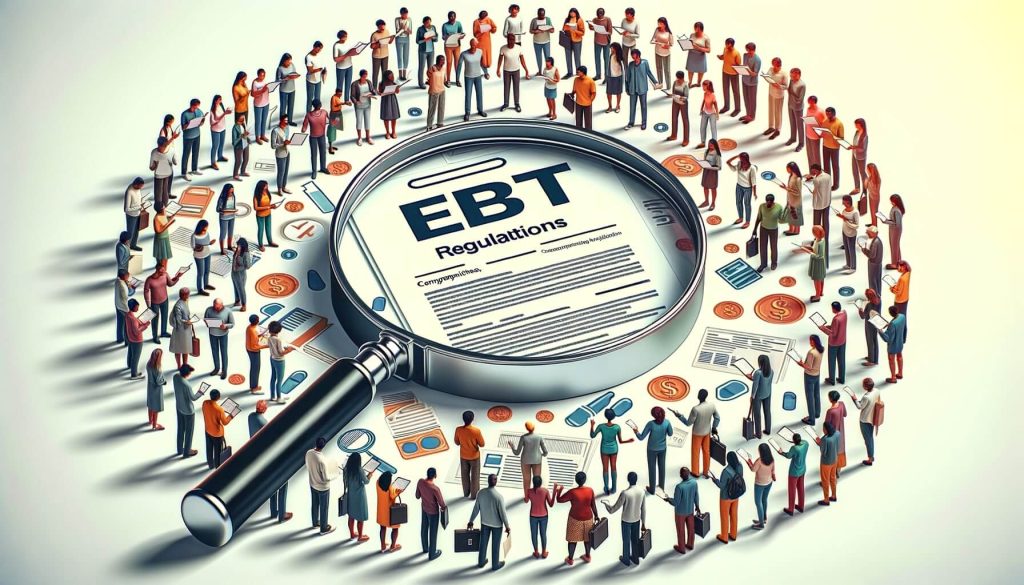
By Ethan Brooks February 9, 2025
In today’s competitive retail landscape, convenience stores face numerous challenges in attracting and retaining customers. One significant hurdle is the perception that larger retailers offer a wider range of payment options, including Electronic Benefit Transfer (EBT). EBT is a government program that provides eligible individuals with funds to purchase food and other essential items.
By accepting EBT, convenience stores can level the playing field and tap into a significant customer base. In this article, we will explore the benefits of accepting EBT, how to get started, setting up EBT equipment, ensuring compliance, promoting EBT acceptance, maximizing EBT sales, overcoming challenges, and address frequently asked questions about EBT for convenience stores.
The Benefits of Accepting EBT: Leveling the Playing Field

Accepting EBT at convenience stores offers several advantages that can help level the playing field against larger retailers. Firstly, it allows convenience stores to tap into a significant customer base. According to the United States Department of Agriculture (USDA), over 42 million individuals participated in the Supplemental Nutrition Assistance Program (SNAP) in 2020. By accepting EBT, convenience stores can attract these customers and increase foot traffic.
Secondly, accepting EBT can lead to increased sales and revenue. A study conducted by the USDA found that SNAP participants spend approximately $70 billion annually on food. By accepting EBT, convenience stores can capture a portion of this spending and boost their bottom line.
Furthermore, accepting EBT can enhance the store’s reputation and community standing. By providing a convenient and inclusive shopping experience for SNAP participants, convenience stores can build loyalty and goodwill among customers. This can lead to positive word-of-mouth referrals and repeat business.
How to Get Started: Applying for EBT Authorization

To accept EBT at a convenience store, owners must first apply for EBT authorization. The process involves several steps, including completing an application, attending a training session, and passing a compliance review.
1. Research EBT Programs: Before applying, convenience store owners should research the EBT programs available in their state. Each state has its own EBT program, and the requirements and application process may vary.
2. Complete the Application: Once familiar with the state’s EBT program, owners can complete the application form. The application typically requires information about the store’s ownership, location, and financial details.
3. Attend Training: After submitting the application, owners may be required to attend a training session. The training provides an overview of EBT regulations, guidelines, and best practices.
4. Pass Compliance Review: Following the training, the store will undergo a compliance review to ensure it meets all EBT requirements. This may involve inspections of the store’s equipment, policies, and procedures.
5. Receive Authorization: If the store passes the compliance review, it will receive authorization to accept EBT. The authorization typically includes the issuance of EBT equipment and a merchant identification number.
Setting Up EBT Equipment: Choosing the Right Technology

Once authorized to accept EBT, convenience store owners must set up the necessary equipment to process EBT transactions. Choosing the right technology is crucial to ensure seamless and efficient EBT acceptance.
1. Point-of-Sale (POS) Systems: Many convenience stores already have POS systems in place. These systems can often be upgraded to accept EBT by installing the necessary software and hardware components.
2. Standalone EBT Terminals: Alternatively, convenience stores can opt for standalone EBT terminals. These devices are specifically designed to process EBT transactions and may offer additional features such as card payment acceptance.
3. Mobile EBT Solutions: For convenience stores with limited counter space or those operating in outdoor markets or events, mobile EBT solutions can be a viable option. These solutions allow store owners to accept EBT payments using smartphones or tablets.
4. Consider Security and Compliance: When choosing EBT equipment, it is essential to prioritize security and compliance. Ensure that the selected technology meets all industry standards and encryption requirements to protect customer data.
5. Train Staff: Once the EBT equipment is set up, it is crucial to train store staff on how to use it effectively. This includes understanding the EBT process, troubleshooting common issues, and ensuring compliance with EBT regulations.
Ensuring Compliance: Understanding EBT Regulations and Guidelines

To successfully accept EBT, convenience stores must adhere to EBT regulations and guidelines. Understanding and implementing these requirements is essential to avoid penalties and maintain eligibility for the program.
1. Eligible Items: EBT funds can only be used to purchase eligible food items. Convenience store owners must familiarize themselves with the USDA’s guidelines on eligible items and ensure that their inventory complies with these regulations.
2. Pricing and Taxation: EBT regulations prohibit stores from charging higher prices for EBT-eligible items compared to non-EBT items. Additionally, sales tax cannot be charged on EBT purchases.
3. Transaction Limits: EBT transactions are subject to daily and monthly limits. Store owners must ensure that their systems can enforce these limits and prevent customers from exceeding their allocated funds.
4. Record-Keeping: Convenience stores accepting EBT must maintain accurate records of EBT transactions. This includes keeping receipts, reconciling sales, and retaining records for a specified period, typically two years.
5. Compliance Audits: EBT program administrators may conduct compliance audits to ensure stores are following the regulations. It is crucial for convenience store owners to keep their records organized and readily available for audit purposes.
Promoting EBT Acceptance: Attracting and Retaining Customers
Once a convenience store is authorized to accept EBT, it is essential to promote this acceptance to attract and retain customers. Implementing effective marketing strategies can help raise awareness and drive foot traffic.
1. Signage and Displays: Place visible signage and displays in-store to inform customers that EBT is accepted. This can include window decals, shelf tags, and banners near the entrance.
2. Online Presence: Leverage the store’s online presence to promote EBT acceptance. Update the store’s website and social media profiles to highlight this payment option and its benefits.
3. Collaborate with Community Organizations: Partner with local community organizations, such as food banks or social service agencies, to promote EBT acceptance. These organizations can help spread the word to their clients and provide referrals.
4. Educational Materials: Create educational materials, such as brochures or flyers, that explain the EBT program and its benefits. Distribute these materials in-store and at community events.
5. Train Staff on EBT: Ensure that store staff are knowledgeable about the EBT program and its requirements. They should be able to answer customer questions and provide assistance during EBT transactions.
Maximizing EBT Sales: Strategies for Increasing Revenue
To maximize EBT sales and revenue, convenience store owners can implement various strategies that encourage customers to choose their store over competitors.
1. Expand EBT-Eligible Inventory: Increase the variety of EBT-eligible items available in-store. This can include fresh produce, dairy products, and other nutritious options. Offering a wide selection can attract more EBT customers and increase sales.
2. Create EBT-Friendly Promotions: Develop promotions specifically targeted at EBT customers. This can include discounts on EBT-eligible items, loyalty programs, or special offers for EBT users.
3. Cross-Promote Non-EBT Items: Encourage EBT customers to explore non-EBT items by cross-promoting them in-store. For example, place EBT-eligible items near non-EBT items to increase exposure and potentially drive additional sales.
4. Provide Excellent Customer Service: Deliver exceptional customer service to all customers, including those using EBT. A positive shopping experience can lead to repeat business and positive word-of-mouth referrals.
5. Monitor and Analyze Sales Data: Regularly review sales data to identify trends and opportunities for improvement. This can help store owners make informed decisions about inventory management, pricing, and promotions.
Overcoming Challenges: Dealing with Potential Issues and Limitations
While accepting EBT offers numerous benefits, convenience stores may encounter challenges and limitations. Being aware of these potential issues and having strategies in place to overcome them is crucial for success.
1. Equipment Malfunctions: EBT equipment may experience technical issues or malfunctions. It is essential to have a backup plan in place, such as alternative payment methods, to ensure uninterrupted service for customers.
2. Training and Staff Knowledge: Inadequate training or lack of knowledge among staff members can lead to errors during EBT transactions. Regularly train and update staff on EBT procedures to minimize mistakes and provide a smooth customer experience.
3. Inventory Management: Managing EBT-eligible inventory can be challenging, especially for smaller convenience stores with limited storage space. Implement effective inventory management practices to ensure a consistent supply of EBT-eligible items.
4. Fraud Prevention: EBT transactions are susceptible to fraud, such as the unauthorized use of EBT cards or the sale of non-eligible items. Implement fraud prevention measures, such as verifying customer identification and monitoring transactions for suspicious activity.
5. Customer Education: Some EBT customers may be unfamiliar with the program’s rules and guidelines. Provide clear and concise information to customers about eligible items, transaction limits, and other relevant details to avoid misunderstandings and potential conflicts.
Frequently Asked Questions (FAQs) about EBT for Convenience Stores
Q1: What is EBT?
A1: EBT stands for Electronic Benefit Transfer, a government program that provides eligible individuals with funds to purchase food and other essential items.
Q2: How can accepting EBT benefit convenience stores?
A2: Accepting EBT can attract a significant customer base, increase sales and revenue, and enhance the store’s reputation and community standing.
Q3: How can convenience stores apply for EBT authorization?
A3: Convenience store owners can apply for EBT authorization by researching the EBT programs available in their state, completing an application, attending a training session, and passing a compliance review.
Q4: What types of EBT equipment can convenience stores use?
A4: Convenience stores can choose from point-of-sale (POS) systems, standalone EBT terminals, or mobile EBT solutions to process EBT transactions.
Q5: What are some compliance requirements for accepting EBT?
A5: Convenience stores must adhere to regulations regarding eligible items, pricing and taxation, transaction limits, record-keeping, and compliance audits.
Q6: How can convenience stores promote EBT acceptance?
A6: Convenience stores can promote EBT acceptance through signage and displays, online presence, collaboration with community organizations, and educational materials.
Q7: What strategies can convenience stores use to maximize EBT sales?
A7: Convenience stores can expand their EBT-eligible inventory, create EBT-friendly promotions, cross-promote non-EBT items, provide excellent customer service, and monitor sales data.
Q8: What challenges may convenience stores face when accepting EBT?
A8: Potential challenges include equipment malfunctions, training and staff knowledge, inventory management, fraud prevention, and customer education.
Conclusion
Accepting EBT at convenience stores is a strategic move that can level the playing field against larger retailers. By understanding the importance of EBT, convenience store owners can tap into a significant customer base, increase sales and revenue, and enhance their reputation within the community. Getting started with EBT authorization involves completing an application, attending training, and passing a compliance review.
Choosing the right EBT equipment, ensuring compliance with regulations, and promoting EBT acceptance are crucial steps for success. By implementing effective strategies and overcoming potential challenges, convenience stores can maximize EBT sales and provide a seamless shopping experience for EBT customers.